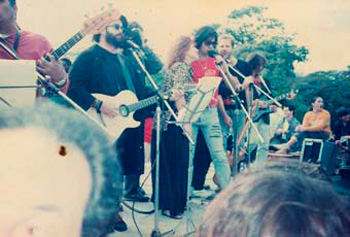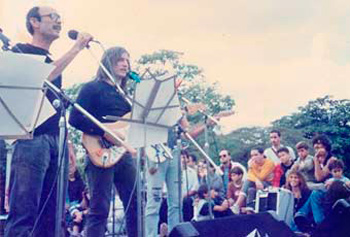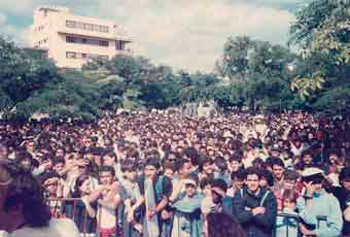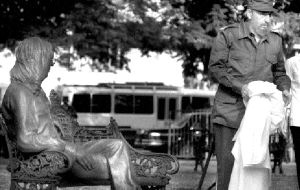The True (Forgotten) Story of Havana’s John Lennon Park
To my brother Santiago Feliu in heaven, and to his beautiful son Mateo, born on March 7, 2014
Jorge Dalton* (Cafe Fuerte)

HAVANA TIMES — In December of 1990, I took part in one of the most beautiful music events I can recall. I am referring to the first, great concert held as tribute to John Lennon in Havana, at the park located on the intersection of 17 and 6th streets in Vedado. Years later, a statue of Lennon would be unveiled there and the park would officially come to be named after the legendary English musician.
The first homage to Lennon began to be organized months before as an initiative of Cuban musicians Carlos and Ele Alfonso and the band Sintesis. They were later joined by the renowned singers Carlos Varela, Santiago Feliu, Pepe Piñeiro (a former member of Los Pacificos), Dagoberto Pedraja, the band Gens, Pablo Menendez and his band Mezcla, Gerardo Alfonso and, of course, a group of filmmakers, writers, painters, technicians and other passionate friends who shared the half-baked dream of paying tribute to Lennon and the Beatles, as well as right the injustice that the banning of the Liverpool Four in Cuba during the 60s and 70s had meant.
A Terrace at the Heart of Havana
Ele and Carlos Alfonso invited me to a meeting of the members of the organizing committee, to discuss how we would all contribute to the concert. I was asked to direct the broadcasting of the concert on television, having access to four video cameras and a broadcast truck from the Cuban Radio and Television Institute (ICRT), where I worked.
The concert was to be held in the lower terraced roof of the Habana Libre Hotel, located on L and 23rd street, the very heart of Havana’s La Rampa area and one of the busiest intersections in the capital. The plan was to set up the sound and video equipment on a Friday and to make this coincide with the activities surrounding the Havana Film Festival, but to do so without any kind of publicity or previous announcement.
The musicians involved would arrive in the afternoon and simply quick off the concert with Beatles songs, to surprise the city and passersby, in the same way John, Paul, George and Ringo had done in England for the concert they held in their last years as a band, later popularly referred to as the “rooftop concert” or “concert on the Apple Studios roof.”

The idea was brilliant. We were all together on this, convinced that we were putting together something never before seen in Cuba. I managed to secure the support of the ICRT (even though I was on pretty bad terms with Juanito Hernandez, the director of Canal 6 and one of the vice-presidents of the ICRT), and I was authorized to use the broadcast truck, four video cameras and all of the technical staff I needed. In addition, I had the support of the crew of A Capella, a television show I had created and was hosting at the time, along with Guille Vilar, Lily Renteria, Lola Pedro, Gloria Diliz, Tomas Pliego and Gladys Infante. Jose Llanes, Ivan Oms, Miguelito Candelario, Jorge Trinchet and Camilo Hernandez, members of the Taller de los Inundados (“Flood Victims Workshop”) had also joined us.
Everything was going well, until we were summoned to a meeting by the National Committee of the Young Communists League (UJC) in Old Havana, in front of the Museum of the Revolution. At this meeting, we were told that the idea for the concert on the Habana Libre lower terrace was “inappropriate.” The UJC had become involved in the project and, until that day, had given us its full support.
Petition Denied
They suggested we hold the concert on the rooftop of the offices of the airline companies on 23rd and P streets. This was technically impossible. First, because the public would not see the performers. Second, because the acoustics there were terrible. And last, it was impossible to broadcast the concert from there. To make matters even worse, the winds that blow off the sea in the area in December would simply ruin everything. We continued to insist the concert had to be held at 23rd and L St. and didn’t budge.
A few days later, the Communist Party Leadership informed us through the UJC that the lower rooftop on 23 and L was considered a “strategic location” and that, as such, they could not authorize us to proceed with the concert. After this, the young members of the UJC withdrew their support and we never saw them again.

To top things off, the director of Canal 6 informed me that the ICRT was taking back its support, broadcast truck included. Representatives of the provincial offices of the Party (PCC), headquartered on M street, in front of the ICRT, had met with Juanito Hernandez and suggested he put an end to “that nonsense”, that “silly” Beatles concert we were planning.
That day, I kicked up a huge fuss. So huge, in fact, that Danilo Sirio, the current president of the ICRT, said something along the lines of: “Dalton’s lost it this time.” They almost fired me, because I challenged Juanito Hernandez to a “fist fight” out in the ICRT parking lot. Hernandez was luckily about my size. I was in fact a little taller than he was and I was sure it would be an easy fight, for I had him figured. I regret he left this world without ever tasting one of my punches, because he’d screwed me over many a time with all of his censorship and shit.
Everything began to get screwed or were already more than screwed. Seeing that everyone was down in the dumps, I told Carlos Varela, Santiago Feliu, Isabel “La China”, and Ele and Carlos Alfonso that we could use my rooftop, that we should do everything there and forget about L and 23 – that I would get the cameras somewhere else. That’s when the possibility of doing the concert at the park on 17 street came up. People in the neighborhood there were giving us their support and had decided to help us in the preparations for the concert.
High and Dry
Nearly all official support for the concert had gone down the drain and some musician friends of ours had left us high and dry. The musicians who stuck with us to the end let us use all of the things they had – sound equipment, consoles, cables, instruments, platforms – and we settled for throwing the concert there in the park.
D-Day arrived and the concert became the talk of the town starting the early morning. Early in the afternoon, the park was already full of people, mostly young. You couldn’t fit another soul there when the concert began in an almost improvised way. It was one of the most stirring musical events I ever took part in; one of those I recall and love most.
We didn’t have much at our disposal in terms of sound equipment. We got our electricity directly from streetlamps and people’s houses. We barely had time to rehearse (though, in my opinion, Cuban musicians don’t need to rehearse that much for things to work out – and that’s exactly what happened). Everything turned out better than we expected. The park was also surrounded by a long cordon of police officers, who ended up singing Yesterday, A Hard Day’s Night, Come Together and Let It Be along with us.
Most of the people gathered there belonged to the generation that called itself “the children of Wilhelm Tell.” Carlos Varela, accompanied by the rock band Gens, made the gathering even more moving by playing his piece Guillermo Tell, which was almost like a personal anthem for us. The crowds were touched like never before. Once he had finishing singing the famous piece, Varela took the microphone and proposed baptizing the park with the name of John Lennon (its name to this day). Suddenly, the band started playing Hey Jude and the unforgettable concert closed with everyone singing the piece along.
Fidel Castro: A Decade Later

The crew of A Capella managed to record part of the concert and we aired a special show hosted by Lily Renteria. I don’t know whether the short footage we shot has survived.
Our friend, “El Mongui”, a filmmaker who works at ICAIC, shot something in 35 mm, but I’ve never seen it. I know there are very few photos of the concert and very little talk about what happened there or what that hugely popular concert meant.
A decade later, on the same spot, they held a ceremony attended by Fidel Castro and other government authorities, with all of the logistic and technical support one would expect, as well as excellent sound and lighting equipment. The gathering also saw the attendance of renowned intellectuals, musicians and artists. Ironically, some of the people who had been directly involved in banning the Beatles in Cuba, and even some Party leaders and ICRT officials who had done everything in their power to keep our tribute to Lennon from happening in 1990, were also there.
To give the gathering a final flourish, they unveiled the statue of John Lennon, a work by Cuban sculptor Jose Villa, and, simultaneously, held a rock concert at Havana’s Anti-Imperialist Grandstand – with all imaginable logistic support.
Many believe that was “the great event that breathed life and recognition into the Beatles in Cuba again,” but that’s not the case. Most people are unaware of the first, authentic homage to the Beatles held in Cuba. Today, rummaging through my photo albums, I came across the only five pictures that survive from the roll I shot with my Soviet Zenit, a camara that perished in the “Perfect Storm” of March 13, 1993.
These photos capture part of what took place that day. They inspired me to tell the true, forgotten story of Havana’s John Lennon Park.
* Cuban-Salvadorian filmmaker, son of Salvadorian poet Roque Dalton (1935-1975). He grew up in both Prague and Havana and finally settled in San Salvador, where he currently resides and works as filmmaker.






We visited this park during our visit to Havana last week. Our guide was passionate about the story of people who went there to listen to the Beetles music. Where ever we went, if a band found out we were English, they played Hay Jude, i never realised what an honour that was until now.
Ah lovely Cuba the only people who are really free, god bless
Hello Michael
I hope you’ll visit both Lennon Park, and the Yellow Submarine soon. You can see a marvelous place and remember old stories about the Beatles connecting to your life and youth.
I was there with my wife, last March 2014 I love the park …
Wow. A very nice story. I never knew of this park and I hope to visit the park next visit to Havana. And maybe even visit The Yellow Submarine that Irina Pino writes so fondly of. I never guessed that The Beatles would have been so popular in Cuba. And I called in sick for work the day John Lennon died… It was quite a sad Beatles party. I am glad of your happy memories of what must have been a great show…